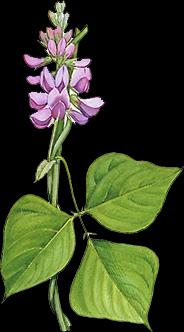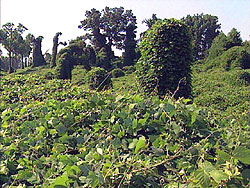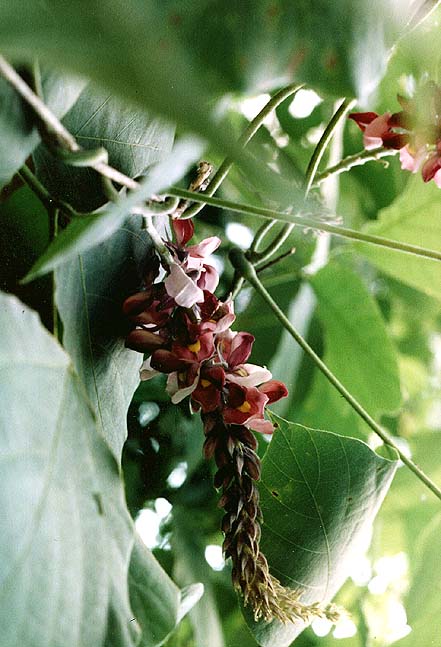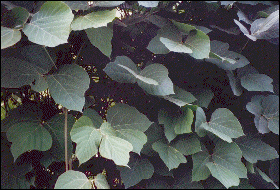

THE FINE ART OF DINING ON KUDZU

We all know that Kudzu has become the nightmare of the South. However, you may be very glad to have that horrible pest climbing all over everything when supplies are low and you need to keep from having scurvy, rickets, and many other conditions brought about by malnutrition.
Common names
for kudzu include:
mile-a-minute vine
foot-a-night vine
and
the vine that ate the South
It's a bean vine. The legume, Pueraria thunbergiana, to be exact.
Kudzu is a coarse, high-climbing, twining, trailing, perennial vine. The huge root, which can grow to the size of a human body, is the source of medicinal preparations used in traditional Chinese medicine and modern herbal products. Kudzu grows in most shaded areas in mountains, fields, along roadsides, thickets, and thin forests, throughout most of China. The root of another Asian species of kudzu, Pueraria thomsonii, is also used for herbal products.
Medicinal Value
Active constituents: Kudzu root is high in isoflavones, such as daidzein, as well as isoflavone glycosides, such as daidzin and puerarin. Depending on its growing conditions, the total isoflavone content varies from 1.77-12.0%, with puerarin in the highest concentration, followed by daidzin and daidzein.
As is the case with other flavonoid-like substances, the constituents in kudzu root are associated with improved microcirculation and blood flow through the coronary arteries. A widely publicized 1993 animal study showed that both daidzin and daidzein inhibit the desire for alcohol. The authors concluded that the root extract may in fact be useful for reducing the urge for alcohol and as treatment for alcoholism. This has not yet been proven in controlled clinical studies with humans.
How much should I take?
The 1985 Chinese Pharmacopoeia suggests 9-15 grams per day of kudzu root.4 In China, tablets of the standardized root (10 mg of weight per tablet equivalent to 1.5 grams of the crude root) are used for angina pectoris. This would equate to 30-120 mg two to three times per day. Kudzu tincture can be used in the amount of 1-2 ml taken three to five times per day.
Are there any side effects or interactions?
At the dosages recommended above, there have been no reports of kudzu toxicity in humans.

In its native lands, the roots are used to make a medicinal tea for treating dysentery and fever. In Japan, a kind of kudzu tofu is highly prized. The stems yield a fiber called ko-kemp that is useful in making cloth and paper. And, last but not least, the plant contains a chemical compound, daidzin, that has proven to be effective in suppressing the craving for alcohol. Indeed, as you read these very words, researchers at Harvard Medical School are hard at work feeding kudzu to alcoholic hampsters in an effort to prove that a kudzu extract used in China and Japan for centuries to treat alcoholism won't kill you!
It's everywhere! So we might as well do something with it. Every part of the Kudzu plant is usable. Try young Kudzu leaves in place of spinach. Deep fried Kudzu leaves are like potato chips. Do a pot of rolled stuffed Kudzu leaves instead of using cabbage... Use the root powder in place of cornstarch and for frying squash or other vegetables....... Make Kudzu wine!

Some Uses, Tips and Recipes
Avoid roadside areas where the kudzu has curled, dead leaves. This indicates it may have been sprayed with pesticides.
You can use kudzu almost as you can any other green, leafy vegetable. Kudzu is good in casseroles, and a few chopped leaves tossed into a basic corn bread recipe add color, texture and a new taste.
Suggestion: Parboil leaves for extra tenderness before adding to other ingredients.
Leaves for Use...
Best Time to Harvest: Pick tender kudzu leaves in spring and early summer. Young leaves at the end of the vines may be collected at any time. Make sure you are not using leaves that have been sprayed with herbicide!
Important Note: Make darn sure you've picked kudzu. It has a three leaf arrangement, but so does poison ivy and poison oak! If you are from the South and don't know what kudzu is, you are probably already dead, but don't make it any worse!
The root of the kudzu vine (which can weigh up to several hundred pounds) can be harvested and used to make kudzu powder.

Note: The recipes below DO call for specific ingredients, but when have we ever used exactly what a recipe calls for? Use your imagination...Be creative.
Formulas...
How to Fix Boiled Kudzu Stems
Boiled Kudzu Stems are a classic southern treat! They're easy to make and a great summer snack!
Difficulty Level: Easy
Time Required: 2 - 3 hours
Here's How:
Select fresh kudzu stems either at your local overgrown lot, kudzu festival market or if you're outside the south, from a kudzu Internet grocer. They should be very firm and "hairy."
Tips:
If you plan to keep your kudzu stems for several days, cover them and place in refrigerator. Kudzu stems may get sticky if left in a warm room for over 5 days and develop molds.
If you made
your kudzu stems too salty (a real impossibility), place them in plain
water for an hour or two. (Remember osmosis from chemistry class?)
To rewarm kudzu stems, place them in a pot with hot water. Microwave rewarming sometimes makes the kudzu stems feel sticky.
The large Carolina kudzu stems are absolutely wonderful to boil. Try them if you can get them!
Kudzu quiche
Makes 4 to 6 servings
1 cup heavy cream
3 eggs, beaten
1 cup chopped young, tender kudzu leaves and stems
1/2 teaspoon salt
1 cup grated mozzarella cheese
1 9-inch unbaked pastry pie shell
Preheat oven to 350 degrees. Mix first six ingredients. Place in pie shell. Bake in preheated oven for 35 to 45 minutes, or until set.
Kudzu and Turnips
Makes 4 servings
4 thick slices bacon
1 pound turnips
1 cup chopped kudzu leaves and stems
1 tablespoon butter
1 cup water
1 tablespoon sugar
2 tablespoons reserved bacon drippings
Salt and pepper to taste
In a skillet, fry bacon until crisp. Peel and cut turnips into small cubes. Chop kudzu leaves. Combine with turnips in a medium saucepan. Add butter, water, sugar and bacon drippings. Season to taste with salt and pepper. Cook over medium heat about 1 hour, covered, until turnips are tender. Garnish with crumbled bacon on top. Serve with corn bread. (Chopped kudzu can also be added to any corn bread recipe.)
Kudzu and Broccoli Casserole
Makes 6 servings
1 10-3/4-oz. can cream of broccoli or cream of celery soup
4 oz. grated cheddar cheese
2 cups broccoli flowerets
1 cup chopped kudzu
1 2.8-oz. can onion rings
1 cup diced meat such as ham (optional)
Preheat oven to 350°. Warm soup and cheese together. Layer half the broccoli, half the kudzu and half the onion rings in a buttered 1-1/2-quart casserole dish. Add diced meat if desired. Pour half of cheese soup over this. Add another layer of broccoli and kudzu. Pour remaining cheese sauce over this. Sprinkle remaining onion rings on top. Bake in preheated oven for 30-40 minutes.
Kudzu and Seafood Casserole
Makes 6 servings
1 cup uncooked rice, cooked according to package directions
Kudzu (complete leaves), enough to cover an 8x11-inch dish
1 pound fresh large shrimp
1/2 pound crabmeat
3 hard-boiled eggs
2 cups sharp cheddar cheese
2 10-3/4-oz. cans cream of shrimp soup
3 tablespoons sherry (regular, not cooking sherry)
1 cup buttered bread crumbs
Spread cooked rice in bottom of 8x11-inch casserole dish. After parboiling kudzu leaves, put them over the rice. Peel and devein shrimp and layer over kudzu. Add layer of crabmeat. Slice eggs and layer on top of seafood. On stove, combine cheddar and cream of shrimp soup. Stir until cheese is completely melted. Add sherry and stir well. Pour sauce over entire casserole. Bake in 350° oven until bubbly (15-20 minutes). Take out and put break crumbs atop casserole. Brown under broiler for no more than 3 minutes.
Kudzu Blossom Jelly
Spoon over cream cheese, or melt and serve over waffles and ice cream.
4 cups Kudzu
blossoms
4 cups boiling water
1 tablespoon lemon juice
1 (1-3/4-ounce)package powered pectin
5 cups sugar
WASH kudzu blossoms with cold water, and place them in a large bowl. Pour 4 cups boiling water over blossoms, and refrigerate 8 hours or overnight. POUR blossoms and liquid through a colander into a Dutch oven, discarding blossoms. ADD lemon juice and pectin; bring to a full rolling boil over high heat, stirring constantly. Stir in sugar; return to a full rolling boil, and boil, stirring constantly, 1 minute. Remove from heat; skim off foam with a spoon. QUICKLY pour jelly into hot, sterilized jars, filling to 1/4 inch from top. Wipe jar rims. Cover at once with metal lids, and screw on bands. PROCESS in boiling water bath 5 minutes. Cool on wire racks. YIELD: 6 half pints NOTE : Blossom liquid is gray until lemon juice is added.
Rolled Kudzu Leaves
Kudzu Leaves
1 can diced tomatoes
2 teaspoons salt
3 cloves garlic, cut in half
Juice of
3 lemons Soup bones (optional)
Gather about 30 medium size young kudzu leaves. ( The very big ones have tough center and radiating stem veins ).
Make sure area has not been sprayed with chemicals to kill the kudzu.
Stuffing
1 cup rice, rinsed in water
1 pound ground lamb or lean beef
1 cup canned diced tomatoes
1/2 teaspoon of allspice
Salt and Pepper to taste
Combine all ingredients and mix well.